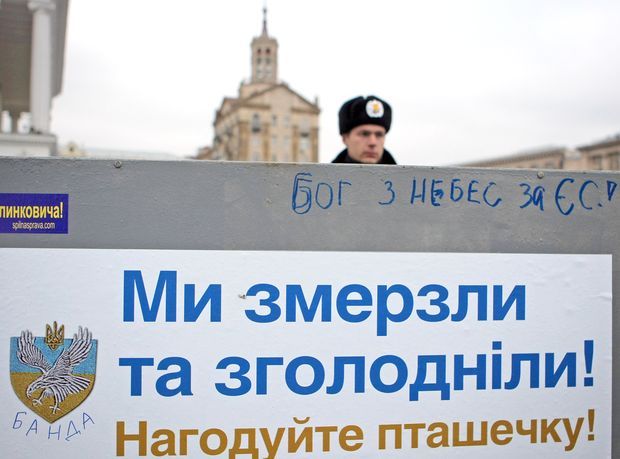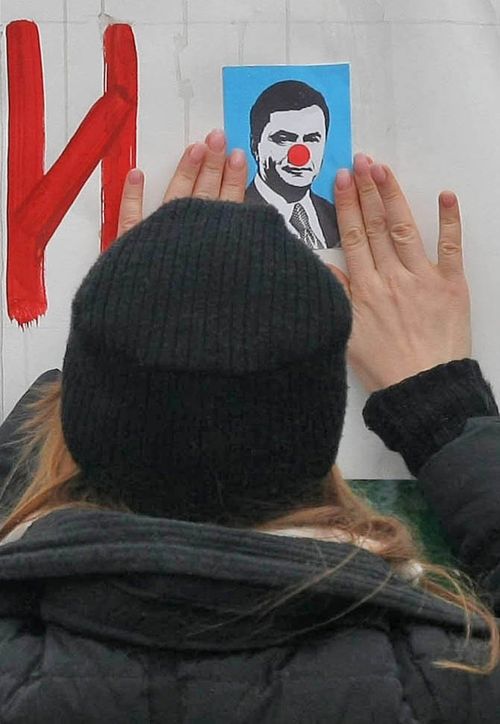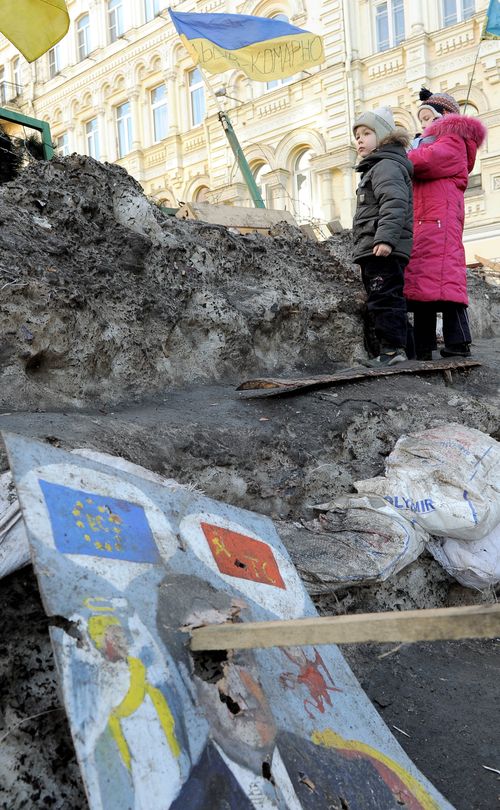Rough language
The Day continues our series of publications about the art of the Revolution of Dignity
After the web, posters and fliers were the most widespread media of the urban riots and the chief channels of the public outrage. Describing, systematizing, and analyzing the Euromaidan publishing output would take a dedicated voluminous study, so we will just outline trends below.
One of the most popular (and sinister in hindsight) stickers of the Euromaidan’s student period reads: “We are hungry and shivering. Feed a bird, please!” accompanied by the emblem of riot police Berkut (Golden Eagle). Similar imagery included stickers that read “Police, let us stand here for the EU,” a series of drawings on whatman paper which were glued on the very fence that separated the Euromaidan from the police, pieces full of mischievous Dadaism and inscribed “I want to wear green pants, not a (Russian) quilted jacket,” pictures of fishtails or women’s legs in a skirt that were glued to the fence exactly where a policeman stood, handwritten appeal “Away with the panda!” (a pun on the world banda, i.e., criminal gang) and the like. This entire output showed tense recklessness of its creators, who tried to convince themselves as well as the regime that victory would be achieved through playful acts and celebrations again, as it was in 2004.

Photo by Ruslan KANIUKA, The Day
Following the November 30 crackdown attempt, this prankish mood made way for defiance. Immediately after the violent dispersal of the student camp, it was an edited screenshot from the new film adaptation of Stephen King’s Carrie that was the most popular image, showing the face of the film’s protagonist, covered in blood, with added yellow and blue stripes on the cheeks and the inscription “Let us protect our children” (incidentally, the Ukrainian premiere of Carrie took place on the second day of the Euromaidan, November 22, on a hill just above the square, at the Kinopalats cinema that had later to close because of fighting). The first banners, made by hand on that Black Saturday, carried the Russian-language rebus puzzle, consisting of the inscription “Oni okhu” and the picture of firs, with the solution being an obscene way to say “They have gone too far.” Khreshchatyk Street long had a canvas hanging over it and carrying another picture of fir and the inscription “Plant trees instead of jailing people” [planting and jailing can be expressed with the same word in Ukrainian. – Ed.]. The protesters’ collective intelligence reacted to challenges quickly and wittily. When the Security Council Secretary Andrii Kliuiev tried to introduce censorship on the main TV channels, some participants of the next mass Sunday rally raised the banner that read: “Help! Hooligan Kliuiev is taking away our TV!” The clashes in Hrushevskoho Street had barely started by the time that light-boxes in the surrounding streets were covered with fliers reading “The guy in the helmet, you are my hero!”, “Every true man has been to Hrushevskoho Street!”, “The guy in the helmet is my first choice for the father of my unborn child,” the latter with lipstick prints on it. Cartoons of Viktor Yanukovych, Mykola Azarov, Vladimir Putin, and other rulers hated by the Euromaidan made up a special set of images, as they were printed out and got whole stands covered in them.
Another consequence of the November 30 assault was the coming of professionals to the protest art. Regardless of the genre, these groups were of similar genesis and format: they appeared on November 30 or December 1-2, immediately launched their pages on social networks, avoided stating individual authorship, and published finished works on free-of-charge websites. The Strike Poster design community’s motto was “The little printer has never felt itself such a hero before.” These Strikers became famous almost overnight, creating a pop art portrait of Yanukovych with a bloodstained pig snout instead of a nose, and a perfect laconic composition based on the national flag: a drop that falls into the blue-and-yellow ocean with the line “I am a drop in the ocean that will change Ukraine” became a symbol of the protest as much as the barricade or the burning tire were. There were many variations in blue and yellow using the drop, ranging from impassioned “I am responsible for what will happen tomorrow” to rude “I am going to the rally because I want to see you (i.e., Yanukovych) shitting your pants!” (it was a call to come to a Sunday rally). A separate interactive project spun off soon, with its own platform www.kraplya.com.

Photo by Ruslan KANIUKA, The Day
The most popular subjects of posters were Yanukovych and Azarov, just like with the cartoons; the chief difference was that the posters were about calls for resistance and defense of one’s rights rather than about ridiculing or humiliating the regime.
Undoubtedly, the poster art, which involved all protesters with the slightest drawing ability, not only served as a mobilizing factor, but was also a kind of art therapy, and in any case, the anonymous author of the poster must get a place in the pantheon of revolutionary figures, should one be ever created.






